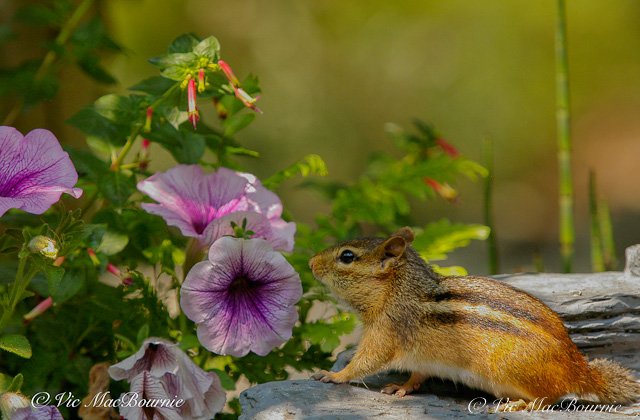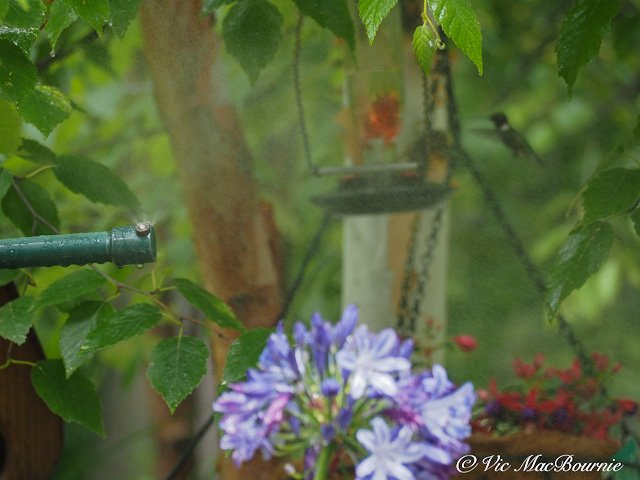Create a hummingbird hangout in your garden
By adding their favourite annual and perennial flowers, a variety of feeders, bugs and water, how can they resist?
Creating a hangout for hummingbirds is not only relatively simple, it will provide hours of entertainment during the summer as more and more of the winged visitors decide your garden is the place to be this summer.
The main ingredients for your hummingbird haven should focus on natural feeders (their favourite nectar-producing annual and perennial flowers) a couple of store bought feeders with a DIY 4:1 water to-sugar-ratio mixture and, if possible, a gentle source of water for a refreshing bath. The gentle source of water can be as simple as a mister or small solar powered fountain in a bird feeder or even a shallow pool of water.
This spring, I decided to focus on creating a central area in the garden that is particularly attractive to hummingbirds. An area that I knew the hummingbirds couldn’t resist but, also, one that would give me the best vantage point to photograph our little friends.
Obviously, hummingbirds were not the only target. I knew that backyard pollinators, like our native bees and butterflies and even other birds, would be regular visitors to the hummingbird hangout, but the focus is definitely on the hummingbirds that have appeared in the backyard every spring for a number of years.
The hummingbird corner aimed at attracting as many of the birds as possible.
Hummingbird hangout makes for the perfect outdoor photo studio
In the past, commercial feeders, native plants and annuals have been situated around our patio attracting them to the general area where I wanted to photograph them. This year, however, my plan was to focus their activity in a smaller corner of the patio and create a natural setting that would make photography much easier, as well create an environment and backdrop for capturing them in the best light.
What I didn’t realize is that it also would create the ideal backdrop for a host of other garden visitors, from bees to butterflies, birds and, of course, our friendly chipmunks.
For more on hummingbirds in the garden, check out the following posts:
• How to help Hummingbirds during migration
• Five tips to attract hummingbirds
Creating the hummingbird hangout
My idea for the hummingbird hangout was simple: Provide the hummingbirds with as many of the flowers they love as natural feeding stations, add a couple of different commercial feeders and place both the feeders and containers filled with their favourite flowers around our container pond equipped with a small waterfalls that I’m hoping will bring even more hummingbirds into the area.
I’m hoping the combination of high-quality, natural feeding stations of their favourite flowers, a reliable source of nectar from the traditional hummingbird feeders and the added sound of gentle running water, will be too much for them to ignore.
The pond and flowers will also attract a myriad of smaller insects and spiders which, we cannot forget, is the number one food source for hummingbirds, especially when they are raising young.
The entire hummingbird hangout is backed by a birch tree clump that is particularly attractive to insects – hummingbirds favourite food source.
Adding a waterfalls to the hangout
I was lucky to have an unused, natural-looking waterfalls that fit perfectly into the container pond and enabled me to create an instant multi-tiered waterfalls. Earlier in the spring, I had seen a Youtube video that showed hummingbirds attracted to a small waterfalls, so, I thought, why not add it to their hangout?
By using a small, inexpensive solar panel and water pump, I hoped to create enough flow to add a nice sound to the entire design. I quickly learned, however, that the inexpensive solar pumps from Amazon and other on-line locations were not going to cut it in this instance.
Not only did these small inexpensive solar-powered pumps struggle to move enough water, the slightest cloud would shut the system down, reducing the joy of having the waterfalls running on a consistent basis.
A hummingbird feeds from what turns out to be the favourite hummingbird feeder.
Getting the best solar-powered water pump for the job
Instead, I opted for a more expensive (but still relatively cheap) larger solar panel and pump that included a built-in battery that the solar panel is able to charge over the course of the day.
The performance of this new, larger solar panel and small pump made by NFESOLAR has been nothing short of outstanding. Not only does it push the perfect amount of water over the falls, it does so even if the sun is behind a cloud. That’s when the battery kicks in and provides that additional power needed to keep the waterfalls working throughout the day.
Most small solar panels shut down immediately if they are not in full sun. Even cloudy days will often stop them from working properly.
If working in shaded situations wasn’t enough to sell me on this solar panel and pump combination from NFESOLAR, the fact that it runs late into the evening on its battery power makes this combination perfect for the hummingbird hangout.
Depending on how sunny it was during the day, the pump will continue to work up to about three hours after the sun is no longer shining on the solar panel.
It certainly helps to have the pump run non-stop all day and into the early evening. Having a continuous flow of water provides birds who visit the waterfalls with the assurance that it will be running during the day. Although I have only seen a single chickadee on the waterfalls in the first weeks of its operation, I’m sure more birds will test the waters once they discover it.
By adding a small amount of seeds on the waterfalls, I’ve encouraged our chipmunks to check it out on a daily basis.
On very hot days, I have a mister that attaches to a hose that can be added to the hangout to make it even more desirable for the hummingbirds and other backyard wildlife.
What plants to use to entice the hummingbirds?
There are a host of plants that can be used to attract hummingbirds, but I opted for a combination of annuals and perennials.
The plants include three Cuphea annual plants (also go by the names firecracker plant or Vermillion), Salvia black and blue annual, columbines, petunias, fuschia and perennial salvia. Very nearby are several cardinal flowers as well as two stands of bee balm.
I have also used plants to create a more natural feel around the pond, including maidenhair and Boston ferns, scouring rush (used in a separate container as well as inside the pond), a hardy dwarf water lilly and pond, a pond bluebell and oxygenators to keep the water fresh.
For a complete list of some of the best hummingbird plants to use in containers or even hanging baskets, check out my earlier post here.
Best hummingbird feeders
When you are choosing the feeders for your hummingbird hangout, consider offering at least a couple of alternatives. I have two feeders hanging from a birch tree directly over the pond and container plants. Another large glass feeder hangs nearby.
One of the two feeders hanging in the birch tree is a large glass feeder, the other is a small tubular feeder that is meant to be hung in a container or hanging basket. Because it is so light, I can hang it out on a small branch for easy access by the hummingbirds. Without any doubt, this is their favourite. In fact, it is so popular I am having to fill up the feeder on a daily basis.
The larger, glass feeder is a great backup in case the smaller tubular feeder is emptied before I can refill it.
I’ve had this larger glass feeder for years and it has performed well, and is easy to clean.
Neither the larger glass feeder or the smaller tubular feeder have perches for the birds to sit on while they feed, but the large feeder nearby has four perches for the birds to feed while resting. The hummingbirds seem to like the perches at times, especially if they are feeding for a prolonged period.
Although the feeders in the hangout don’t have feeding perches for the hummingbirds, I have included a small branch for the birds to land on just above the waterfalls, as well as a larger branch for other birds to stop by a check out the neighbourhood.
However, the birds tend to just hang out in the many small branches provided by the birch tree.
In fact, the hummingbird hangout sits on our patio on the edge of what I like to call our birch grove. The area is made up of three large clump birches overhanging a dry-river bed with a bubbling rock at one end. The shady area is a favourite spot for birds looking for insects and a quick visit to the bubbling rock.
Birch trees attract a lot of insects and caterpillars to the garden and therefore are important trees for hummingbirds and other birds during nesting season when they need an abundance of protein to feed their growing offspring.







